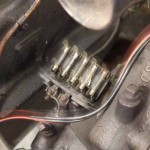1937 Dodge Pickup
This 1937 Dodge Pickup came to us in rough shape and in pieces. We did a complete rebuild and restoration to get it looking like new.
Explore the Project Galleries
Arrival
Strip & Metal Fab
Mechanical
Body & Paint
Finish
Dodge truck sales hit rock bottom in 1932, but so did the rest of the industry as this was the year which proved to be the worst of the Great Depression. Fortunately Chrysler’s fortunes reversed and sales increased by a factor of eight during the Glamour years of 1933 to 1935. Mr. Chrysler was never one to sit still. His company fielded an interesting, modern, and advanced line of trucks in 1936.
The new trucks featured Fore-Point load distribution which was a fancy term marketing used for their construction. Dodge engineers moved the front axles forward which shifted the load forward in relation to the axles. This way the front axles carried more of the load’s weight than previously able. Fore-Point resulted in greater stability
and allowed for a minimum over-all length.
Another major change in the construction of 1936 light-duty trucks was the adoption of a truck-type frame featuring parallel side rails with double drops and five heavy cross members. Moving the front axle forward and the change to a truck-type frame meant that for the first time Dodge half-ton commercials were real trucks.
Early in 1937 Dodge management introduced a new 3/4-1 ton series. The series differed from the previous 3/4-1 ton models in that the new trucks were styled with the same look as the half-ton trucks; not as lighter models of a larger truck. Models offered included a panel, pickup, canopy, and screen. Dodge 3/4-1 ton trucks were available on both 120- and 136-inch wheelbase chassis designed for mounting seven or nine-foot bodies.
Read more about Dodge Pickups at: http://www.pickuptrucks.com/html/history/segment4.html

















